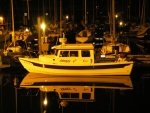ssobol":2h53vdwf said:
Would a rescue laser count as a visual signaling device per the required emergency equipment? $90 is less than the cost for two flare sets for something that doesn't expire, is not a fire hazard, and is waterproof.
Here is Boat US assessment of the Greatland Product:
The Greatland Lasers are high powered rescue devices that have an incredible range of 20 – 30 miles in ideal conditions. The presentation laser pointers with which you might be familiar, focus their laser beam into a small dot—while the Greatland products focus the beam into a linear shape. At a close distance the beam is only a few inches wide but at a ¼ mile the beam grows to several feet in width. The linear shape enables the user to sweep the beam (held vertically) back and forth across the intended target.
"We found this product to be heavily affected by the atmospheric conditions during our night testing and difficult to see at all during our day test. With a half moon and the glow of an urban sky, the red Greatland Rescue Laser Flare Magnum proved to be much more difficult to see than the Greatland Green Rescue Laser Flare. Aiming both of the lasers proved difficult due to the ¼ mile testing distance as even a moderate amount of ‘sweeping motion’ by the tester made it difficult for the observers to see the laser. Without radio confirmation it was difficult to tell if the signal was even received. Aiming the green flare into the water and slowly guiding it up to the target proved to be a good method. These products will require a lot of practice to perfect a successful aiming technique....Currently laser signaling devices are not USCG approved. The primary concern with laser signaling devices is that lasers aimed directly at someone’s eyes may lead to laser dazzle where an after image of spots makes it difficult for an aircraft pilot to see. This is an issue manufacturers are working to address. A concern for boaters remains that if a pilot gets hit with a laser flare in the eyes they may abort the mission."
I would have concerns if a SAR pilot saw a green laser flash, that he/she might not investigate it, because of fear of visual impairment--even though the Greatland product apparently will not cause retinal damage at a distance.
From the CG regs:
ELECTRIC S-O-S DISTRESS LIGHT
APPROVAL CATEGORY: 161.013
APPROVAL GUIDANCE & INFORMATION: This is an alternative to flares for recreational boats. It is required to automatically flash S-O-S. Light intensity and duration requirements apply. Electric S-O-S distress lights are self-certified by the manufacturer. The Coast Guard does not issue approvals or keep an authenticated list of manufacturers. Approval standards for these lights are found in Title 46 of the Code of Federal Regulations, Subpart 161.013.
At this time, there is no rescue laser certified to take the place of a night signal from what I can find--and I have looked several times.
I think that there would be an issue with many authorities if you offered up a flashlight which blinks SOS (I have several which do)--instead of flares. There are day signals which are non pyrotechnic which are approved.
The West Marine Catalogue, has the Greatland Laser Flare, (no approval noted). And several strobes which say "CG approved",..but none meet the 161.013 specs.
ACR did have a "puck" type of laser flare, which was approved, but it was withdrawn from the market.
Will any of our CG AUX inspectors pass a boat which does not have flares of some type?
As for rescue--I depend on the PLB, flares, SOS and strobe lights. I can see the advantages--and disadvantages of the laser flares.

